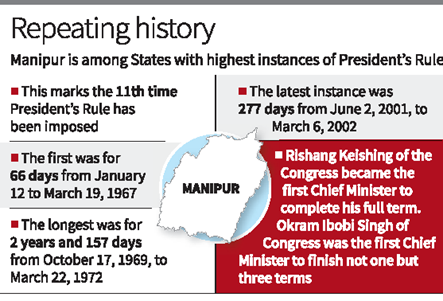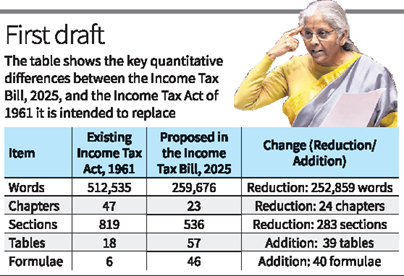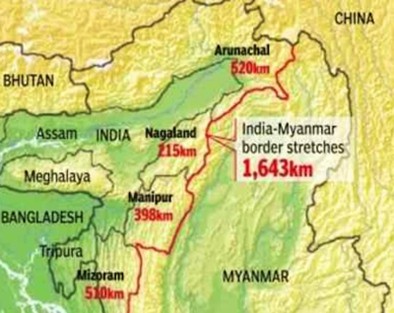Content:
- President’s Rule imposed in Manipur days after CM’s exit
- FM unveils Income Tax Bill 2025 in LS that seeks to simplify compliance
- 22 gates allow free movement of people on India-Myanmar border
- Unloading of Union Carbide waste begins in M.P. town
- Challenges of malaria vaccination, as elimination becomes achievable
- Is appointing ad-hoc judges a viable means to reduce backlog?
- What is happening in the DRC?
President’s Rule imposed in Manipur days after CM’s exit
Context & Background
- Manipur has been witnessing ethnic violence for nearly two years, primarily between the Kuki–Zo and Meitei communities.
Relevance : GS 2(Governance ,Polity)

- Over 250 people have been killed, and approximately 60,000 displaced since violence erupted on May 3, 2023.
- Former CM N. Biren Singh resigned on February 9, 2025, after meeting Home Minister Amit Shah.
Constitutional Basis & Legal Implications
- President Droupadi Murmu invoked Article 356 of the Constitution to impose President’s Rule (PR) in Manipur.
- PR was imposed after Governor Ajay Kumar Bhalla’s report stated that governance could not continue per constitutional provisions.
- The Manipur Legislative Assembly is under “suspended animation“, meaning it is not dissolved but remains inactive.
- Under Article 356(3), the proclamation must be approved by both Houses of Parliament within two months to remain in effect.
Key Takeaways
- Security & Ethnic Tensions: Ongoing conflict remains unresolved, and instability persists.
- Border & Immigration Concerns: Ex-CM linked the crisis to demographic changes and border policies.
- Uncertain Future: PR can last up to six months, extendable with parliamentary approval. The future course depends on political resolution and security stabilization.
Additional Information:
President’s Rule (Article 356) – Key Points
Constitutional Basis
- Article 356 allows the President to impose President’s Rule (PR) in a state.
- PR is imposed when the state government fails to function as per the Constitution.
Grounds for Imposition
- Governor’s report states constitutional breakdown in the state.
- State government defies Union government directives (Article 365).
- Political instability, law and order failure, or inability to conduct elections.
Procedure
- President issues a proclamation imposing PR.
- Must be approved by both Houses of Parliament within two months (Article 356(3)).
- If approved, PR lasts six months, extendable to three years with conditions.
Effects of President’s Rule
- State government is dismissed; Governor takes over with Union government’s guidance.
- State legislature is either dissolved or suspended (Manipur’s case: suspended animation).
- Union government controls state administration via the Governor.
- Laws for the state are made by Parliament.
Judicial Safeguards
- S.R. Bommai Case (1994):
- PR is subject to judicial review.
- Governor’s report is not final and can be challenged.
- State Assembly cannot be dissolved immediately without parliamentary approval.
History of Imposition
- First imposed in Punjab (1951).
- Longest PR in J&K (2018-2019).
- Manipur has seen PR multiple times (1967, 1973, 1979, 1992-95, 2025).
Issues & Concerns
- Weakens federalism by increasing central control.
- Governance impact as bureaucrats replace elected representatives.
- Risk of political misuse to dismiss opposition-led governments
FM unveils Income Tax Bill 2025 in LS that seeks to simplify compliance
Introduction & Purpose:
- Finance Minister Nirmala Sitharaman introduced the Income Tax Bill 2025 in Lok Sabha.
- Aims to simplify the existing Income Tax Act, 1961, which has been amended over 4,000 times since 1962.
Relevance : GS 2(Governance )

Legislative Process:
- The Bill will be referred to a Parliamentary Select Committee for review.
Key Structural Changes:
- Word count reduction: From 5.1 lakh words to nearly half.
- Chapters reduced: From 47 to 23 for easier comprehension.
Terminology Simplification:
- “Tax Year” introduced to replace multiple terms like “assessment year” and “previous year.”
- “Financial Year” retained for compliance and procedural timelines.
TDS & TCS Rationalization:
- Multiple provisions consolidated in one place for clarity and ease of compliance.
Implications:
- For Taxpayers & Practitioners:
- Reduces complexity and confusion in tax filing.
- Standardizes terminology to avoid discrepancies.
- For Tax Authorities & Legal System:
- Expected to reduce tax litigation and improve clarity.
- Streamlined structure may enhance compliance and enforcement efficiency.
- Broader Economic Impact:
- A modernized tax framework could improve India’s ease of doing business ranking.
- Potential for increased taxpayer compliance and better revenue collection.
22 gates allow free movement of people on India-Myanmar border
Context & Background
- Free Movement Regime (FMR) History & Changes:
- Introduced in 1968 due to ethnic and familial ties.
- Territorial limit changes:
- 40 km initially → reduced to 16 km (2004) → 10 km (2024).
- Additional regulations enforced in 2016 to strengthen security.
Relevance : GS 2(Governance ,International Relations)

- Operational Border Gates:
- 22 out of 43 crossing points under the revised FMR agreement are functional.
- Distribution of operational gates:
- Manipur: 10 gates
- Mizoram: 5 gates
- Nagaland: 5 gates
- Arunachal Pradesh: 2 gates
- Regulation and Security Measures:
- Assam Rifles designated as the primary agency for issuing border passes and conducting first-level security checks.
- State police forces (Arunachal Pradesh, Nagaland, Mizoram, Manipur) responsible for verification at the place of stay.
- QR code-enabled passes introduced for movement regulation.
- Biometric data recording and central database verification for security screening.
- Political & Security Implications:
- Despite Home Minister’s announcement on scrapping FMR, no formal orders from MEA yet.
- Myanmar faces intensified conflict between Ethnic Armed Organizations (EAOs) and the military junta since coup on Feb 1, 2021.
- Over 40,000 Chin refugees have entered Mizoram and Manipur since the coup.
Significance & Impact
- Humanitarian Aspect:
- Facilitates movement for border communities with deep cross-border ties.
- Ensures controlled access while addressing refugee concerns.
- Security Concerns:
- Increased surveillance amid conflict spillover risks.
- Potential challenges in tracking illegal migration and insurgency threats.
- Diplomatic Angle:
- India’s balancing act in managing border security without disrupting relations with Myanmar’s ethnic groups.
- Unclear future of FMR suspension, given lack of formal MEA directive.
Unloading of Union Carbide waste begins in M.P. town
Context: Unloading of toxic waste from Union Carbide factory in Bhopal starts in Pithampur, Madhya Pradesh, despite protests.
Relevance : GS 2(Governance )
- Timeline: 358 tonnes of chemical waste were moved on January 2 and unloaded on February 13, five days before Jabalpur High Court’s next hearing on February 18.
- Historical Context: The Union Carbide plant was the site of a 1984 gas leak disaster that killed thousands.
- Safety Measures: Dhar Collector Priyank Mishra assures public that waste containers remain locked, and incineration will not start until court hearing.
- Incineration Process: The government plans to incinerate waste at Pithampur facility, but it has been delayed by protests.
- Protests: Locals and activists continue to protest the incineration, fearing environmental and health impacts. Protests include symbolic acts like shavasana (corpse pose).
- Court Involvement: High Court hearing on February 18 will decide the next steps, with local groups focusing on presenting their evidence in court.
- Official Statements: Authorities deny rumours of incineration beginning, confirm unloading is done with safety protocols, and emphasize public consultation for any future action.
- Local Concerns: Locals remain skeptical, and protests are expected to intensify based on court’s ruling.
Methyl Isocyanate (MIC)
- Chemical Formula: CH₃NCO
- Type: Highly toxic and volatile chemical compound.
- Uses: Primarily used in the production of pesticides, especially carbamate pesticides (e.g., Sevin).
- Properties:
- Colorless gas with a pungent odor.
- Extremely reactive and unstable, especially when exposed to moisture or heat.
- Toxicity:
- Causes severe respiratory issues, eye irritation, and damage to the nervous system.
- Can lead to death in high concentrations.
- Bhopal Gas Tragedy:
- MIC was the primary gas released during the 1984 Bhopal disaster.
- Its leakage from a Union Carbide plant resulted in thousands of deaths and long-term health effects for hundreds of thousands of people.
Challenges of malaria vaccination, as elimination becomes achievable
Historical Context of Malaria Discovery
- Malaria was initially misunderstood as a result of miasma (foul air).
- Key discoveries:
- 1880: Alphonse Laveran identified the Plasmodium parasite, proving malaria was caused by a living organism.
- 1897: Ronald Ross demonstrated that Anopheles mosquitoes were the vectors, completing the malaria transmission cycle.
- Malaria’s transmission path shaped colonial powers‘ ability to control regions, ironically reinforcing subjugation rather than liberation.
Relevance : GS 2(Health)
The Complexity of Malaria and Its Vaccine Development
- Parasite life cycle:
- The cycle begins with an infected mosquito injecting Plasmodium sporozoites into a human, infecting the liver, multiplying undetected, then re-entering the bloodstream to infect red blood cells (RBCs).
- Some parasites become gametocytes, which mosquitoes ingest, continuing the transmission cycle.
- Unlike simpler viruses, Plasmodium is a protozoan, evolving multiple developmental stages and surface proteins, complicating immune recognition and vaccine design.
Immune Evasion by Plasmodium
- Antigenic variation: Plasmodium frequently alters its surface proteins, evading the immune system, leading to reinfection and weakened long-term immunity.
- Intracellular lifestyle: The parasite hides within liver cells and RBCs, evading immune surveillance, making immunity harder to develop.
- Genetic adaptability: Plasmodium evolves to evade immune responses, making universal vaccines difficult to develop.
Challenges in Malaria Vaccine Development
- RTS, S Vaccine:
- Targets the liver stage of the parasite by inducing immunity against circum-sporozoite protein (CSP).
- Efficacy is 36% after four doses, much lower than vaccines for viral diseases like measles (90-95%).
- Effectiveness varies across age groups and transmission settings and declines over time.
- Requires multiple doses, complicating distribution in resource-poor regions.
- Second-Generation Vaccines:
- R21/Matrix-M: 77% efficacy over 12 months, shows promise in improving immune response.
- PfSPZ: A whole-parasite vaccine targeting the liver stage.
- RH5-based vaccines: Target the blood stage of infection, preventing RBC invasion.
- Transmission-blocking vaccines: Aim to stop mosquitoes from becoming infectious by targeting Pfs25 and Pfs230 proteins.
Underfunding of Malaria Vaccine Research
- Funding challenges:
- Malaria primarily impacts low-income countries, leading to limited funding for research and healthcare infrastructure.
- Although treatments exist, the urgency for a vaccine has decreased, reducing research prioritization.
- Pharmaceutical barriers: The complexity of the parasite and the high cost of research deter large-scale investment from pharmaceutical companies.
Resurgence of Malaria
- Shifting mosquito habitats and drug resistance are contributing to malaria’s resurgence, especially in regions where environmental factors and urbanization alter the landscape.
- A comprehensive strategy for malaria control will require:
- More effective vaccines.
- Enhanced mosquito control methods.
- Improved treatment options to address drug resistance.
Long-Term Outlook
- While malaria elimination is achievable, the path remains challenging.
- The development of a universal, long-lasting vaccine faces hurdles due to the parasite’s adaptability and complexity.
- Combination strategies that integrate vaccines, vector control, and treatments will be key in eradicating malaria globally.
Is appointing ad-hoc judges a viable means to reduce backlog?
Viability of Ad-Hoc Appointments:
- The Supreme Court’s endorsement of ad-hoc judges aims to address the 62 lakh case backlog in High Courts as of January 2025.
- Previous attempts at ad-hoc appointments have been minimal, but renewed hope exists with recent judicial intervention.
- High judicial vacancies (367 out of 1,122) highlight the need for immediate action to reduce the backlog.
Relevance : GS 2(Indian Judiciary)
Impact on Regular Judicial Appointment Process:
- India has lacked a systematic approach to address judicial delays for 75 years, with concerns over the handling of regular judicial appointments.
- Ad-hoc appointments do not interfere with the regular appointment process and provide timely relief, especially for criminal cases.
Reforming the Ad-Hoc Appointment Process:
- Simplifying the appointment process is key: The Chief Justice of High Courts should directly recommend candidates to the Supreme Court collegium.
- Avoid unnecessary procedures like intelligence clearances to speed up the appointment process and avoid discouraging candidates.
Impact on Judicial Careers and Seniority:
- Ad-hoc judges serve for 2-3 years and do not compete with sitting judges, meaning they do not affect the seniority of current judges.
- Article 224A ensures that ad-hoc judges cannot be elevated, protecting the promotion prospects of regular judges.
Strain on Judicial Infrastructure:
- The government must ensure resources like stenographers and law researchers for ad-hoc judges to focus on judicial duties.
- High Courts already have the capacity to accommodate additional courtrooms, and logistical challenges can be addressed by reassigning staff.
Attracting Judges to Return to the Bench:
- Financial incentives and privileges are necessary to attract retired judges, as alternatives like arbitration and independent practice are more lucrative.
- The restriction on practicing in the same High Court after serving as an ad-hoc judge may discourage some candidates.
Judicial Independence Concerns:
- Personal connections with the legal community do not inherently compromise judicial independence.
- Careful selection of candidates with integrity and technical expertise is crucial to maintaining judicial independence.
Conclusion:
- Ad-hoc appointments can offer immediate relief for reducing case backlogs, particularly in criminal appeals, without disrupting the regular judicial system.
- The effectiveness of this measure depends on simplifying the appointment process, ensuring government cooperation, and providing necessary logistical support.
Additional notes:
Ad-Hoc Judges in Indian Polity
- Definition: Ad-hoc judges are temporary appointments made to handle the mounting backlog of cases in the judiciary. They are typically retired judges appointed for a limited term to assist in case adjudication.
- Constitutional Provision: Article 224A of the Indian Constitution allows the appointment of ad-hoc judges in the Supreme Court and High Courts to address judicial pendency.
- Recent Developments: In January 2025, the Supreme Court authorized High Courts to appoint retired judges on an ad-hoc basis to hear criminal appeals, working alongside sitting judges.
- Challenges:
- The process requires presidential approval, making government cooperation essential.
- Despite constitutional provisions, the practice has been limited in scope, with only a few ad-hoc appointments in the past.
- Benefits:
- Provides immediate relief in reducing case backlogs, especially in criminal cases.
- Does not affect the seniority or career progression of sitting judges.
- Concerns:
- The appointment process has been cumbersome, with calls for simplification to speed up the process.
- Judicial independence must be maintained by ensuring only candidates of impeccable integrity are appointed.
What is happening in the DRC?
Current Situation:
- M23 militia, backed by Rwanda, captures Goma: The DRC’s mineral-rich city of Goma, located near the Rwanda border, was captured by the M23 militia in early 2025.
- Casualties and Displacement: UN estimates state that over 2,900 people have died, 700,000 displaced, and many others injured since January 2025 due to escalating violence.
- M23’s Advances: The militia has now set its sights on Bukavu, another resource-rich area, as conflict spreads south.
Relevance : GS 2(International Relations )
Historical Context of the Region:
- Ethnic Conflicts Between Hutus and Tutsis: The region’s strife began during the colonial era under Belgian rule, where the Tutsi minority held power, leading to resentment from the Hutu majority.
- The 1959 Hutu Revolution and Rwanda’s Independence: The Hutu revolution, which resulted in the deaths of 20,000 Tutsis, led to a shift in power and the eventual independence of Rwanda in 1962.
- The Rwandan Genocide (1994): Sparked by the assassination of President Habyarimana, the genocide saw the systematic slaughter of Tutsis and moderate Hutus, claiming around 800,000 lives in 100 days.
Aftermath of the Genocide:
- Hutu Refugees in DRC: Post-genocide, millions of Hutus, including perpetrators of the violence, fled to DRC, leading to the formation of several armed groups, including the M23.
- Invasions by Rwanda in 1996 and 1998: Rwanda invaded DRC twice, citing the need to protect Tutsi interests, triggering the First and Second Congo Wars, which caused massive regional instability.
- The Second Congo War (1998-2003): Known as Africa’s World War, it involved nine nations and 25 armed groups, resulting in 5 million deaths.
The M23 Militia:
- Formation and Goals: M23, formed in 2012, emerged from a breakaway faction of the Congolese Army (CNDP). The group’s stated aim is to protect Tutsis, and it has a history of capturing Goma.
- Renewed Activity: The M23 resurfaced in 2022, citing unmet promises from the DRC government, and is accused of war crimes by the UN.
- Leadership: The militia is led by Sultani Makenga and is primarily based in the North Kivu province.
Ethnic Strife vs. Resource Wealth:
- Ethnic Tensions: While ethnic strife between Hutus and Tutsis plays a role, the DRC’s vast mineral resources are central to the conflict.
- Coltan as a Key Resource: The DRC is a significant global source of Coltan, a crucial mineral for electronic devices, which is a major factor in the region’s appeal for both armed groups and nations.
Responses to the Crisis:
- DRC’s President Tshisekedi’s Statement: DRC President Felix Tshisekedi termed the capture of Goma as “an act of war” and faces political challenges due to the loss.
- Rwanda’s Role and Kagame’s Stance: Rwandan President Paul Kagame has not directly admitted Rwanda’s support for M23 but has suggested that the group’s actions represent legitimate Tutsi interests.
- Burundi’s Warnings: Burundi, with its own tensions with Rwanda, has expressed concern over M23’s advance, warning that further conquest could lead to broader regional war.
- Uganda’s Position: Uganda takes a middle ground by assisting Congolese troops against militants linked to ISIS while indirectly allowing M23 to use Ugandan territory.




